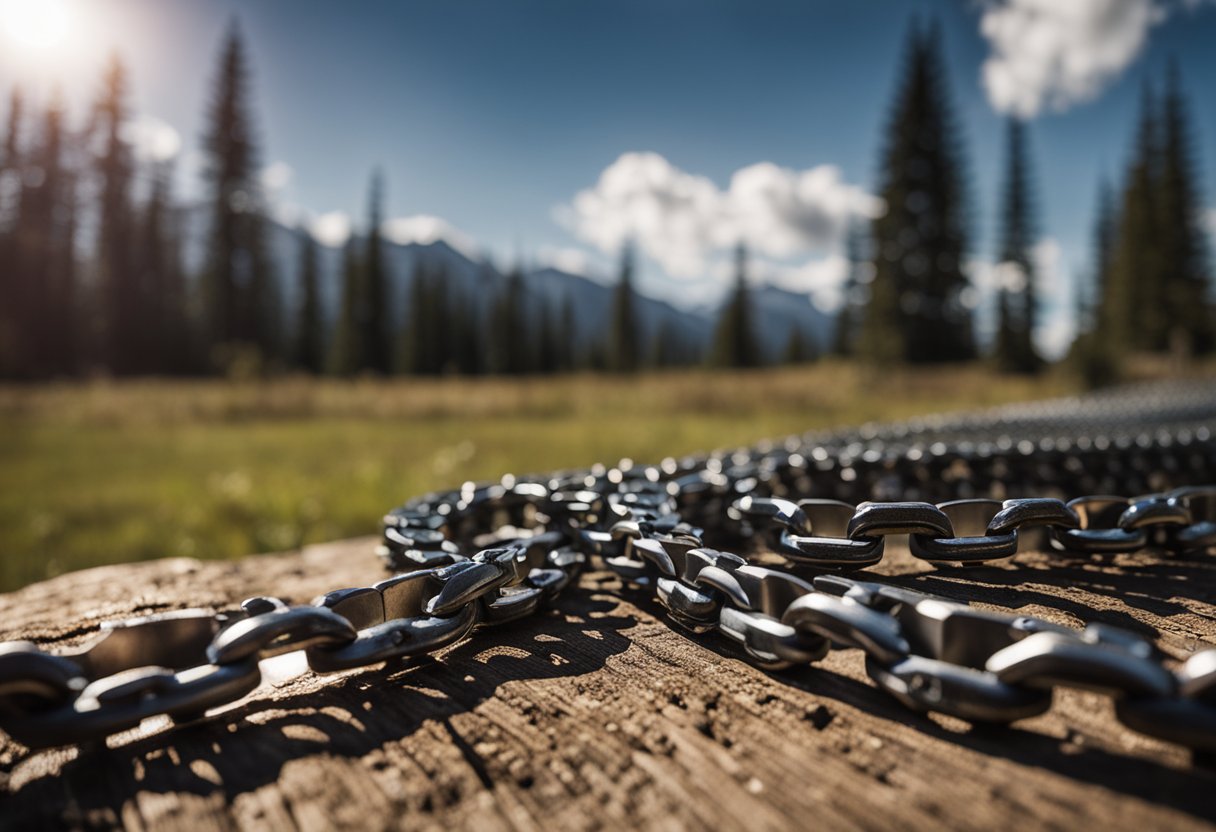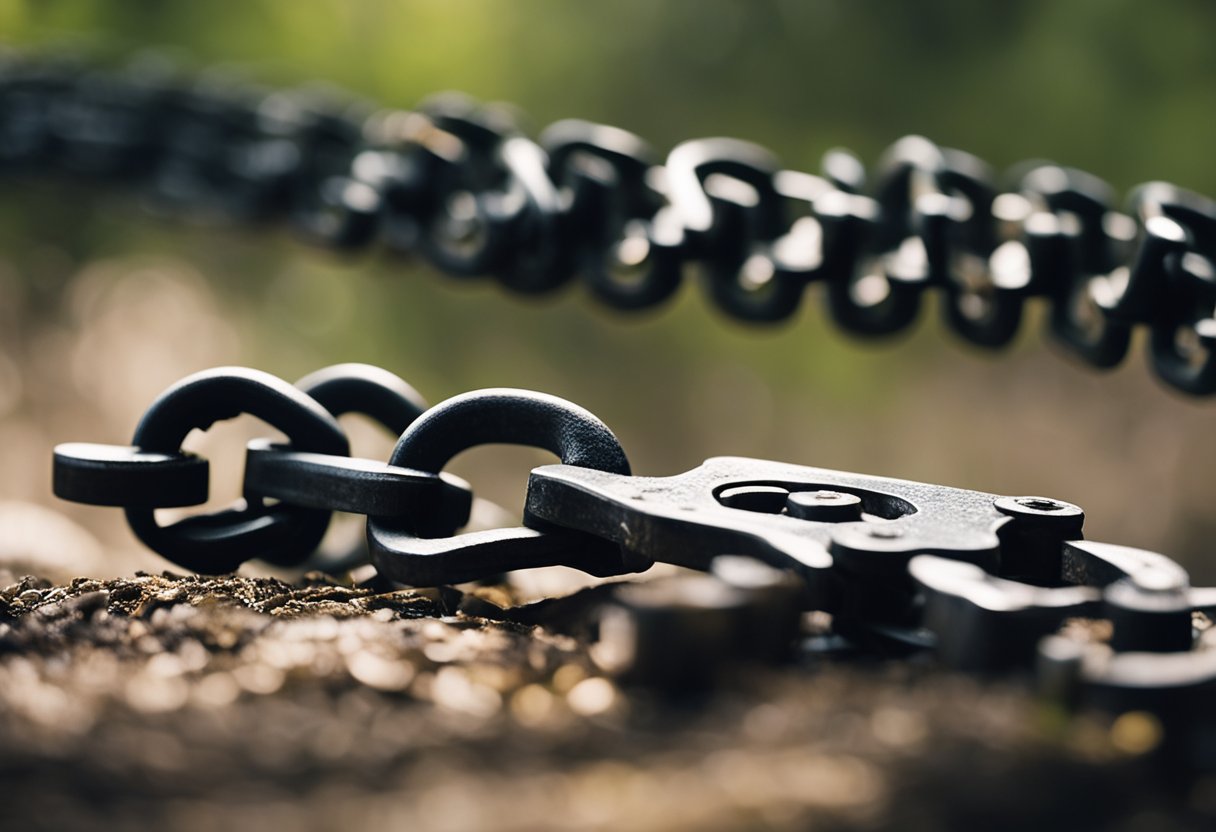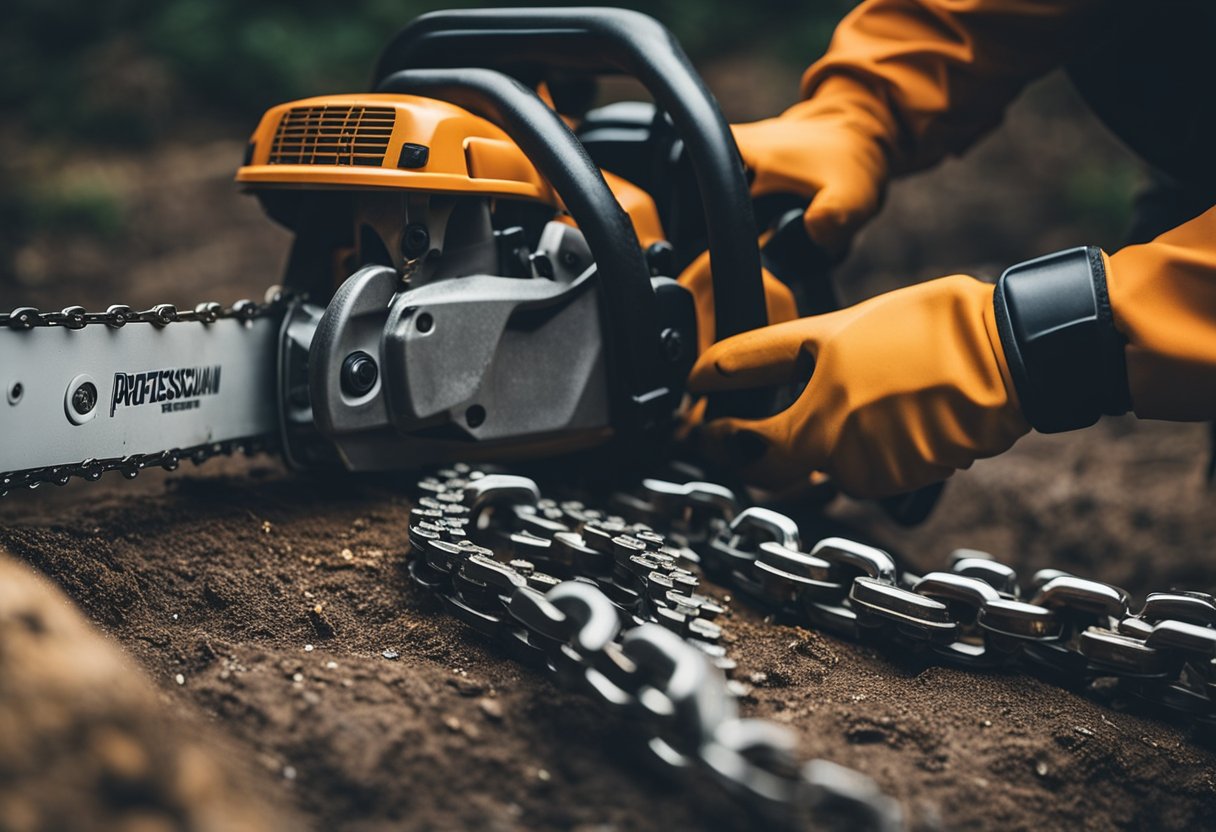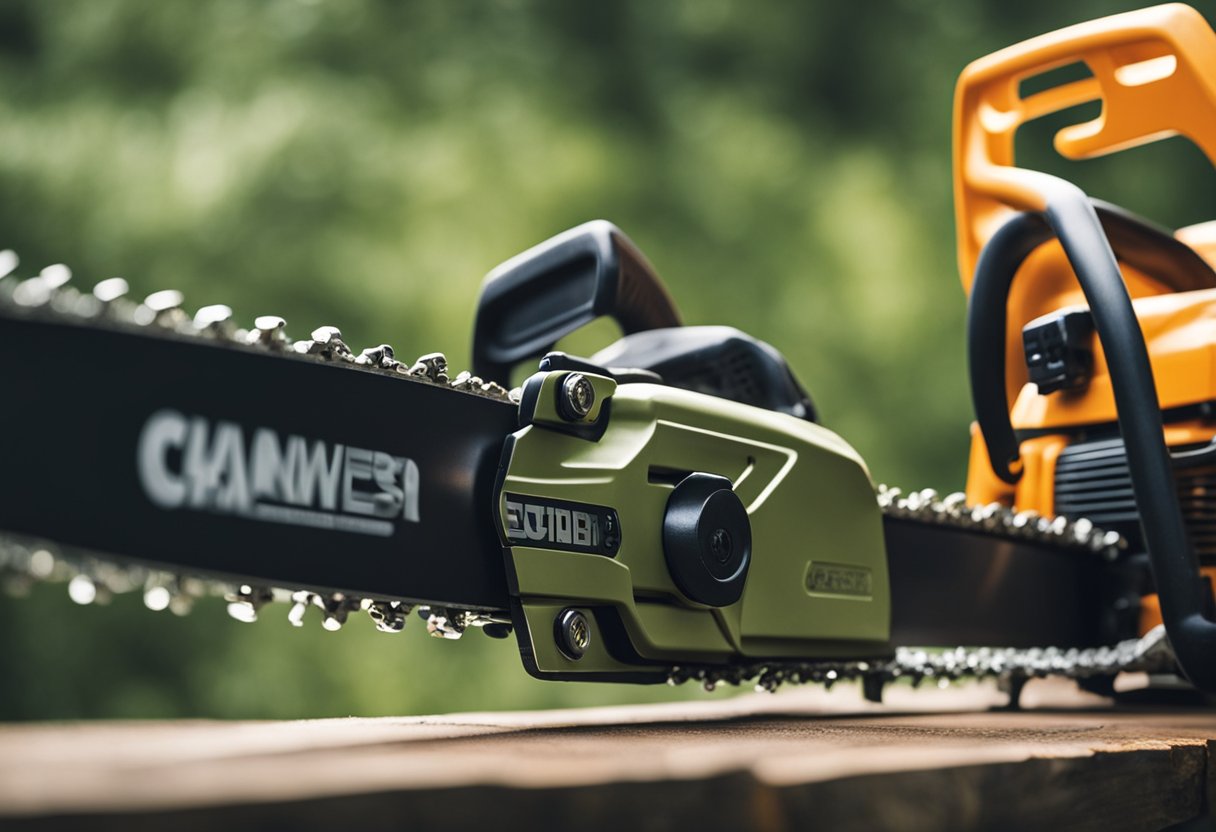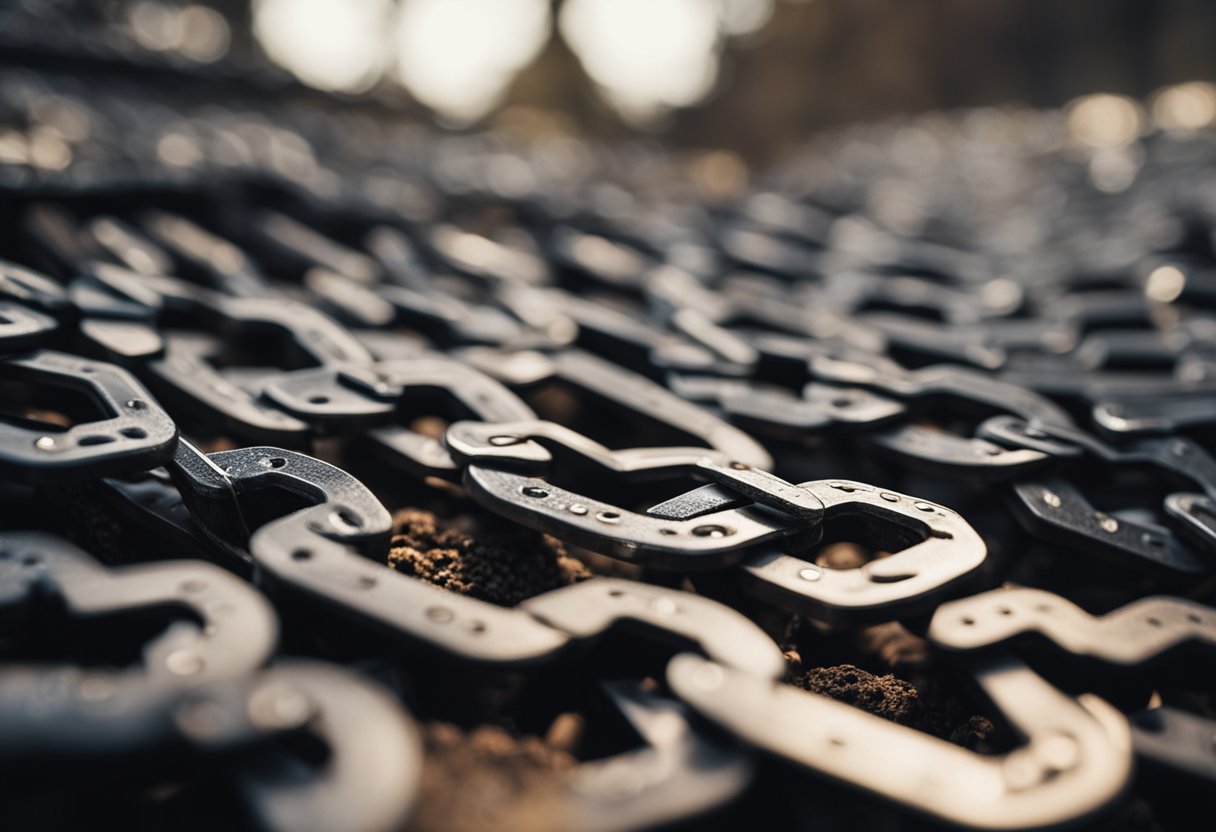How long does a chainsaw chain last? This is one of the most common questions asked by chainsaw users. The answer is not straightforward as there are many factors that can affect the life expectancy of a chainsaw chain. In this article, I will provide a comprehensive guide on the life expectancy of chainsaw chains and the factors that can affect their lifespan.
Understanding Chainsaw Chains
Before discussing the lifespan of chainsaw chains, it is essential to understand what a chainsaw chain is. A chainsaw chain is made up of a series of cutting teeth that are attached to a chain. The chain is driven by a sprocket on the chainsaw bar, and as it rotates, the cutting teeth cut through the wood. The cutting teeth are designed to be sharpened, but over time, they will wear down and need to be replaced.
Key Takeaways
- Chainsaw chains can last anywhere from 1-20 years depending on usage and maintenance.
- Factors such as chain type, lubrication, and sharpening can affect the lifespan of chainsaw chains.
- Signs of a worn-out chainsaw chain include dull cutting teeth, overheating, and difficulty cutting through wood.
Understanding Chainsaw Chains
https://www.youtube.com/watch?v=iY-qgN6StuQ&embed=true
As a chainsaw user, it is essential to understand the basic components of a chainsaw chain. A chainsaw chain consists of a series of teeth that are attached to a metal chain. The teeth are responsible for cutting through wood, while the chain provides the necessary power to drive the teeth. The chain is made of metal, and the teeth are made of various materials, including steel and carbide.
The life expectancy of a chainsaw chain is determined by its use and maintenance, not by a predetermined timeline or expiration date. With frequent use, a chainsaw chain can last for 5+ years, while occasional users can expect a chain to last for decades. However, cutting hardwood and excessive sharpening can reduce its lifespan. Striking a balance in chain maintenance is crucial for optimal performance and longevity.
It is essential to choose the right chainsaw chain for the job. Different chainsaw chains are designed for specific purposes, such as cutting softwood, hardwood, or frozen wood. Using the wrong chain can result in poor performance, damage to the chain, or even injury to the user.
In addition to choosing the right chain, proper maintenance is also crucial. Regular cleaning and lubrication can help extend the life of the chain. Sharpening the teeth when they become dull is also essential. Dull teeth can cause the chainsaw to work harder, leading to increased wear and tear on the chain.
In conclusion, understanding the basic components of a chainsaw chain and proper maintenance techniques can help extend the life of the chain. Choosing the right chain for the job and using it correctly can also help ensure optimal performance and longevity.
Life Expectancy of Chainsaw Chains
https://www.youtube.com/watch?v=ulao–cOHfU&embed=true
As a professional woodworker, I have extensive experience using chainsaws. One of the most common questions I get asked is, “How long does a chainsaw chain last?” The answer is not as straightforward as you might think. The lifespan of a chainsaw chain depends on several factors, including the quality of the chain, how often you use it, and how well you maintain it.
Generally speaking, a high-quality chainsaw chain can last anywhere from a few months to several years. However, the life expectancy of a chainsaw chain is not determined by a pre-determined timeline or expiration date. Instead, it is determined by its use and maintenance. With proper care, a chain can last for months or up to 5 years.
There are several factors that can affect the longevity of a chainsaw chain. For example, cutting hardwood and excessive sharpening can reduce its lifespan. On the other hand, proper maintenance and usage can extend the life of the chain. It is important to strike a balance in chain maintenance to ensure optimal performance and longevity.
To help you understand the factors that affect the life expectancy of a chainsaw chain, I have created the following table:
| Factors Affecting Chainsaw Chain Life Expectancy |
|---|
| Quality of the chain |
| Frequency of use |
| Type of wood being cut |
| Proper maintenance and usage |
| Frequency of sharpening |
| Environmental factors (e.g. moisture, temperature) |
In summary, the life expectancy of a chainsaw chain is not set in stone. It depends on several factors, including the quality of the chain, how often you use it, and how well you maintain it. By striking a balance in chain maintenance and usage, you can extend the life of your chainsaw chain and ensure optimal performance.
Factors Affecting Chainsaw Chain Lifespan
As an experienced chainsaw user, I have learned that the lifespan of a chainsaw chain can vary depending on several factors. In this section, I will discuss the most important factors that affect the lifespan of a chainsaw chain.
Type of Use
The type of use is one of the most important factors that affect the lifespan of a chainsaw chain. If you are a professional logger who uses the chainsaw daily, the chain will wear out faster than if you are an occasional user who uses it once or twice a year. According to my research, heavy usage and neglect can cause a chainsaw chain to wear out in as little as a few months [1].
Maintenance
Proper maintenance is crucial to extending the lifespan of a chainsaw chain. Regular cleaning and sharpening can help prevent wear and tear and extend the lifespan of the chain. Neglecting to maintain the chainsaw chain can cause it to wear out faster and require more frequent replacement. In fact, a well-maintained chain can last up to 5 years with regular use [2].
External Factors
External factors such as the type of wood being cut, the frequency of use, and the environment in which the chainsaw is used can also affect the lifespan of a chainsaw chain. For example, cutting hardwoods will cause the chain to wear out faster than cutting softwoods. Similarly, using the chainsaw in wet or dirty conditions can cause the chain to wear out faster.
In conclusion, the lifespan of a chainsaw chain is determined by several factors, including the type of use, maintenance, and external factors. By taking proper care of your chainsaw and using it appropriately, you can extend the lifespan of the chain and save money in the long run.
[1] Source: https://chainsawexperts.com/how-long-does-chainsaw-chain-last/
[2] Source: https://www.thetoolsquare.com/how-long-do-chainsaw-chains-last/
Signs of a Worn-Out Chainsaw Chain
https://www.youtube.com/watch?v=q3iqRxlgg5k&embed=true
As a professional woodworker, I know that a chainsaw chain is an essential tool for cutting wood. However, over time, a chainsaw chain will wear out and become less effective. Here are some signs to look out for to know when it’s time to replace your chainsaw chain:
Dull Chain
If your chainsaw chain is dull, it will take longer to cut through wood, and the cuts will be uneven. You can tell if your chain is dull by looking at the chips it produces. If the chips are small and powdery, your chain is dull and needs to be sharpened or replaced.
Damaged Chain
A damaged chain is a clear sign that it’s time to replace your chainsaw chain. You should inspect your chain regularly for any signs of damage, such as chipped or broken teeth, and replace it immediately if you find any.
Uneven Cuts
If your chainsaw chain is worn out, it will start to produce uneven cuts. You may notice that the saw is pulling to one side or that the cuts are not straight. This is a sign that your chain is no longer cutting efficiently and needs to be replaced.
Poor Cutting Performance
If your chainsaw is no longer cutting efficiently, it may be time to replace the chain. Poor cutting performance can be caused by a dull or damaged chain, or it may be a sign that the chain is worn out and needs to be replaced.
In conclusion, it’s important to inspect your chainsaw chain regularly for signs of wear and damage. If you notice any of the signs mentioned above, it’s time to replace your chainsaw chain to ensure that you can continue to work efficiently and safely.
Maintaining Your Chainsaw Chain
https://www.youtube.com/watch?v=ALMncv9RbaQ&embed=true
As a chainsaw owner, it is important to maintain your chainsaw chain to ensure its longevity and optimal performance. Proper maintenance and care can help extend the lifespan of your chainsaw chain. Here are some key areas to focus on when maintaining your chainsaw chain.
Sharpening
Regular sharpening is crucial to maintaining a chainsaw chain’s effectiveness. A dull chain can cause the chainsaw to work harder than necessary, which can lead to motor damage. It is recommended to sharpen the chainsaw chain after every use or whenever you notice that it is becoming dull. You can sharpen the chain yourself or take it to a professional for sharpening.
Lubrication
Regular lubrication is important to keep your chainsaw chain running smoothly. The chain should be lubricated before each use, and periodically during use. Proper lubrication helps prevent friction and wear on the chain, which can cause it to break or become damaged. Use a high-quality lubricant specifically designed for chainsaws.
Storage
Proper storage is crucial to maintaining the lifespan of your chainsaw chain. When not in use, store the chainsaw in a dry, cool place. Avoid storing it in direct sunlight or in damp areas, as this can cause rust and corrosion. Proper tension is also important when storing the chainsaw. Loosen the chain slightly to relieve tension on the bar and chain, but do not loosen it too much as this can cause the chain to come off the bar.
In summary, regular maintenance and care are essential to keep your chainsaw chain in good shape. Focus on regular sharpening, regular lubrication, and proper storage to extend the lifespan of your chainsaw chain.
Dealing with Common Chainsaw Chain Problems
https://www.youtube.com/watch?v=XAXjlYu1EFE&embed=true
As a chainsaw user, it is important to be aware of common problems that can arise with the chainsaw chain. Here are a few issues you might encounter:
Hitting Rocks or Nails
One of the most common issues with chainsaw chains is hitting rocks or nails. This can cause the chain to become damaged or even break. Always be aware of your surroundings when using a chainsaw and avoid cutting near areas where rocks or nails may be present. If you do hit a rock or nail, inspect the chain for damage and replace it if necessary.
Rusting
Rust is another common problem with chainsaw chains, especially if they are not properly maintained. Rust can cause the chain to become dull and ineffective. To prevent rust, clean and oil your chainsaw chain after each use. If the chain has already started to rust, use a wire brush to remove the rust and then apply oil to prevent further rusting.
Uneven Cuts
If you notice that your chainsaw is making uneven cuts, it could be due to a dull or damaged chain. Check the chain for any signs of damage or wear and replace it if necessary. Uneven cuts can also be caused by improper chain tension, so make sure to adjust the tension as needed.
By being aware of these common chainsaw chain problems and taking the necessary steps to prevent or fix them, you can ensure that your chainsaw stays in good working condition for longer.
Safety Precautions when Using Chainsaw Chains
As someone who has used chainsaws for years, I know how important it is to take safety precautions seriously. Chainsaw chains can be incredibly dangerous if not handled properly. Here are some precautionary measures that I recommend taking to protect yourself and others when using chainsaw chains:
-
Wear appropriate safety gear: Always wear protective gear, such as safety glasses, gloves, and earplugs, when using a chainsaw. Additionally, wear a hard hat to protect your head from falling branches or debris.
-
Use safety lines: If you are working at height, use safety lines to prevent falls. Make sure the lines are securely anchored and can support your weight.
-
Clear the work area: Before starting to cut, clear the work area of any debris, such as rocks or branches, that could interfere with your work. Make sure there are no bystanders nearby who could be injured by flying debris.
-
Keep the saw in good condition: Regularly inspect your chainsaw to make sure it is in good working order. Replace any damaged or worn parts, and keep the chain sharp.
-
Follow proper cutting techniques: Always cut with the bottom of the bar, and never cut above shoulder height. Use a sawhorse or other support to hold the wood in place, and never cut freehand.
By following these safety precautions, you can protect yourself and others when using chainsaw chains. Remember, safety should always be your top priority when working with power tools.
Repair and Replacement of Chainsaw Chains
As a chainsaw chain gets older, it may start to wear and become dull. When this happens, the chain will need to be repaired or replaced. Some common signs that a chainsaw chain needs to be replaced include:
- The chain is broken or damaged
- The chain is worn or dull
- The chain is stretched out and no longer fits snugly around the guide bar
If the chain is broken or damaged, it will need to be replaced. A broken chain cannot be repaired and must be replaced with a new one. If the chain is just worn or dull, it can often be sharpened to extend its life. However, if the chain is too worn, it may need to be replaced.
When replacing a chainsaw chain, it is important to choose the right replacement chain for your saw. Chainsaw chains come in different sizes and types, so it is important to choose the right one for your saw. You can find the correct replacement chain by checking your saw’s manual or by measuring the old chain.
Once you have the new chain, you will need to install it on your saw. This process can vary depending on the type of saw you have, so it is important to follow the instructions in your saw’s manual. Generally, you will need to loosen the tension on the old chain, remove it from the guide bar, and then install the new chain.
In addition to replacing the chain, you may also need to replace other parts of your chainsaw. For example, if the chain is stretched out, you may need to replace the guide bar or the sprocket. It is important to inspect all parts of your chainsaw regularly and replace any parts that are worn or damaged.
Overall, repairing or replacing a chainsaw chain is a straightforward process that can help extend the life of your saw. By keeping your chainsaw in good condition and replacing parts as needed, you can ensure that your saw is always ready to use when you need it.
Frequently Asked Questions
What is the average lifespan of a chainsaw chain?
The lifespan of a chainsaw chain depends on a variety of factors. According to Burly Beaver, a chainsaw chain can last for 5+ years with frequent use. For occasional users, a chain could last for decades. However, the life expectancy of a chainsaw chain is determined by its use and maintenance, not by a pre-determined timeline or expiration date.
What factors affect the longevity of a chainsaw chain?
Several factors affect the longevity of a chainsaw chain. The frequency of use, the type of wood being cut, the quality of the chain, and the maintenance of the chain are all factors that can affect the lifespan of a chainsaw chain. According to Glory Woodworking, most chainsaw chains of different brands can last from 1-5 years. If you’re a logger who needs to use the saw daily, the chain can’t last more than a year or even just 2-3 months. However, if you use it occasionally and properly maintain it, the chain can last more than 5 years or even longer.
How often should a chainsaw chain be replaced?
A chainsaw chain should be replaced when it is worn, damaged, or no longer cuts effectively. According to Chainsaw Guru, how often you should replace a chainsaw chain depends on how frequently you use it and the type of wood you cut. If you use your chainsaw frequently, you may need to replace the chain every few months. If you use it less often, you may only need to replace the chain once a year.
What are some signs that indicate a chainsaw chain needs to be sharpened?
There are several signs that indicate a chainsaw chain needs to be sharpened. The saw may produce sawdust instead of chips, or the chain may pull to one side when cutting. The saw may also require more effort to cut through wood, or the chain may produce smoke or sparks. According to Chainsaw Ace, the chain may also become dull if it comes into contact with dirt, rocks, or other debris.
Can a chainsaw chain be sharpened, or does it need to be replaced?
A chainsaw chain can be sharpened instead of replaced if it is not damaged or worn beyond repair. Sharpening a chainsaw chain involves filing the teeth of the chain to restore their sharpness. According to Chainsaw Guru, you can sharpen a chainsaw chain yourself using a chainsaw file, or you can take it to a professional to have it sharpened.
Are there any tips for maintaining the sharpness of a chainsaw chain?
Maintaining the sharpness of a chainsaw chain involves regular cleaning, proper lubrication, and proper storage. According to The Tool Square, you should clean the chain after each use to remove any debris or dirt. You should also lubricate the chain regularly to prevent overheating and premature wear. Finally, you should store the chainsaw in a dry, cool place to prevent rust and corrosion.

Hi, I’m Sal Muller of Tooltrip.com. My DIY experience led me to understand essential power tools for home projects. Tooltrip.com guides enthusiasts and professionals in choosing right tools for any job. I provide concise top tool reviews for easier, efficient DIY.

